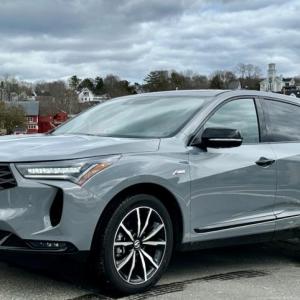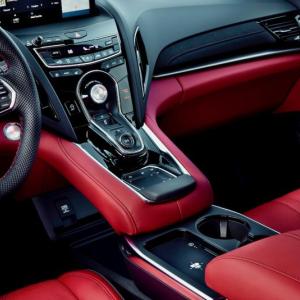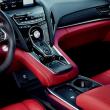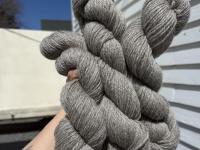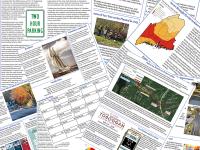For grown-ups only: Acura RDX A-Spec Advance
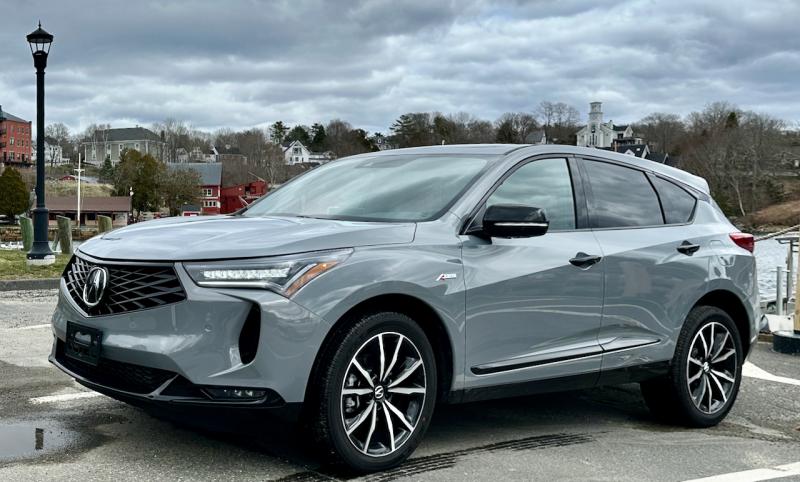 Acura’s smaller, two-row SUV, the RDX, received a mid-cycle update for 2025, including this distinctive grille. The RDX shares a platform with the Honda CR-V ute and the Civic sedan, but there is little resemblance. Our range-topping A-Spec ADV model, here shown, has a sticker price of $56,400. This color is Urban Gray Pearl.
Acura’s smaller, two-row SUV, the RDX, received a mid-cycle update for 2025, including this distinctive grille. The RDX shares a platform with the Honda CR-V ute and the Civic sedan, but there is little resemblance. Our range-topping A-Spec ADV model, here shown, has a sticker price of $56,400. This color is Urban Gray Pearl.
 For 2025, the RDX cabin has been upgraded with more leather and Ultrasuede, a roomier bin in the console, easier access to the phone charging pad and more ambient lighting. The knob in the center is the drive mode selector; beneath that lie the P-R-N-D buttons, with a second setting on the Drive button for S, Sport. And below them is the computer touchpad.
For 2025, the RDX cabin has been upgraded with more leather and Ultrasuede, a roomier bin in the console, easier access to the phone charging pad and more ambient lighting. The knob in the center is the drive mode selector; beneath that lie the P-R-N-D buttons, with a second setting on the Drive button for S, Sport. And below them is the computer touchpad.
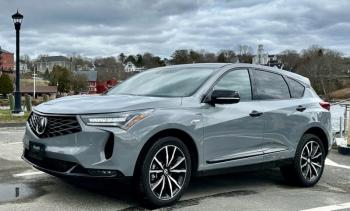 Acura’s smaller, two-row SUV, the RDX, received a mid-cycle update for 2025, including this distinctive grille. The RDX shares a platform with the Honda CR-V ute and the Civic sedan, but there is little resemblance. Our range-topping A-Spec ADV model, here shown, has a sticker price of $56,400. This color is Urban Gray Pearl.
Acura’s smaller, two-row SUV, the RDX, received a mid-cycle update for 2025, including this distinctive grille. The RDX shares a platform with the Honda CR-V ute and the Civic sedan, but there is little resemblance. Our range-topping A-Spec ADV model, here shown, has a sticker price of $56,400. This color is Urban Gray Pearl.
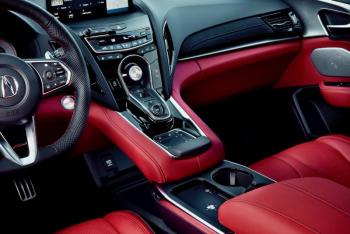 For 2025, the RDX cabin has been upgraded with more leather and Ultrasuede, a roomier bin in the console, easier access to the phone charging pad and more ambient lighting. The knob in the center is the drive mode selector; beneath that lie the P-R-N-D buttons, with a second setting on the Drive button for S, Sport. And below them is the computer touchpad.
For 2025, the RDX cabin has been upgraded with more leather and Ultrasuede, a roomier bin in the console, easier access to the phone charging pad and more ambient lighting. The knob in the center is the drive mode selector; beneath that lie the P-R-N-D buttons, with a second setting on the Drive button for S, Sport. And below them is the computer touchpad.
When the Acura Legend sedan arrived in the U.S., in 1986, we were already imprinted on Honda cars and motorbikes (not to say lawnmowers, snowblowers and outboard motors), so a luxury brand from the same company, while novel, was well received. Toyota and Nissan soon followed with Lexus and Infiniti, and it didn’t take long for distinct identities to emerge for each — identities that have changed little, if at all, in four decades.
I cannot count how many Acura vehicles I’ve driven since 1986, but it’s dozens and dozens. Except for the NSX (see below), all have seemed to be 60% Honda practicality plus 40% luxury with strong notes of down-to-earth common sense.
Save for the rarified and costly mid-engine NSX two-seater (1991 – 2005 and 2016 – 2022, RIP), every Acura has received styling that verges on stodgy, yet beneath the vanilla exterior there’s usually a car or SUV that we can learn to love. Luxury label to the contrary, no Acura has ever been the biggest or the flashiest, the most powerful or lavish or expensive. But when those superlatives become clichéd or tiresome, the Acura is still in the driveway.
Right, the new RDX: As Acuras go, with its ‘jewel-eye’ headlamps and crisp highlights to its sheet metal, it’s downright handsome now. What we see on the outside is what we get inside, too: crispness. The acceleration, handling and response reward the driver, while passengers appreciate the creature comforts—not lavish, but subtly and functionally luxurious.
The 2.0-litre Four is turbocharged to 272 horses and 280 torques, power that is routed through a 10-speed automatic transmission (with a sport setting and shift paddles on the steering wheel) to Honda’s Super Handling All Wheel Drive system. In normal, non-slippery conditions, SH-AWD sends 70% of the power to the rear wheels and can direct 100% of that to the outside rear wheel, to help pivot the vehicle around a corner. This is called torque vectoring and is different from torque steering, which is a bugaboo common to front-wheel drive.
The A-Spec RDX also has the now-obligatory four driving modes: Snow, Comfort, Normal and Sport. These features plus adaptive dampers with three selectable modes make the RDX a pleasure to drive and able to make the most out of the powerful engine.
Honda/Acura persists with its unique push-pull gear selector, which occasionally flummoxes even owners; and the computer touchpad, on the center console below the gear selector, also can be challenging to use, even with its wrist-rest. Otherwise, the ergonomics are fault-free.
For 2025, the console itself has been redesigned with more storage space and easier access to the wireless phone charger, and the cupholders are bigger. Further mild upgrades to the RDX include a widescreen mode in the wireless Apple CarPlay and Android Auto apps and, in the premium A-Spec Advance trim, more leather and Ultrasuede seating, more ambient lighting on the center console, and front- and rear-door speaker cones that light up.
Stacked up against sporting two-row SUVs from Europe, the RDX, even fully loaded and priced, is a value buy; it lacks the sky-high horsepower of a top-end Porsche Macan or BMW X3, but it costs many thousands less. And if the A-Spec Advance trim is still too much, Acura offers seven less expensive versions priced as low as $47,000.
Next week: Genesis GV80 3.5T

